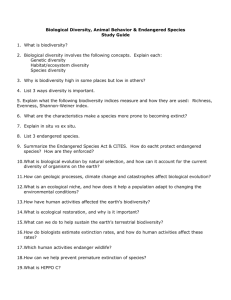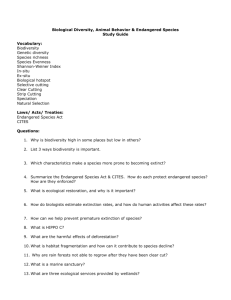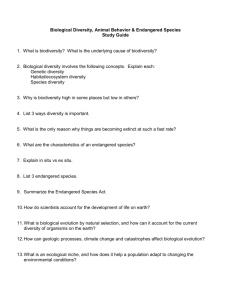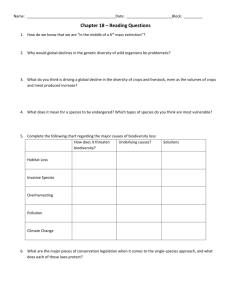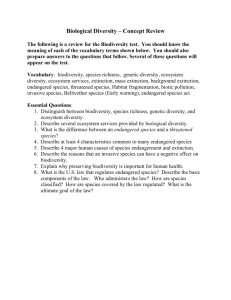MAST Presentation - Maryland Association of Science Teachers
advertisement
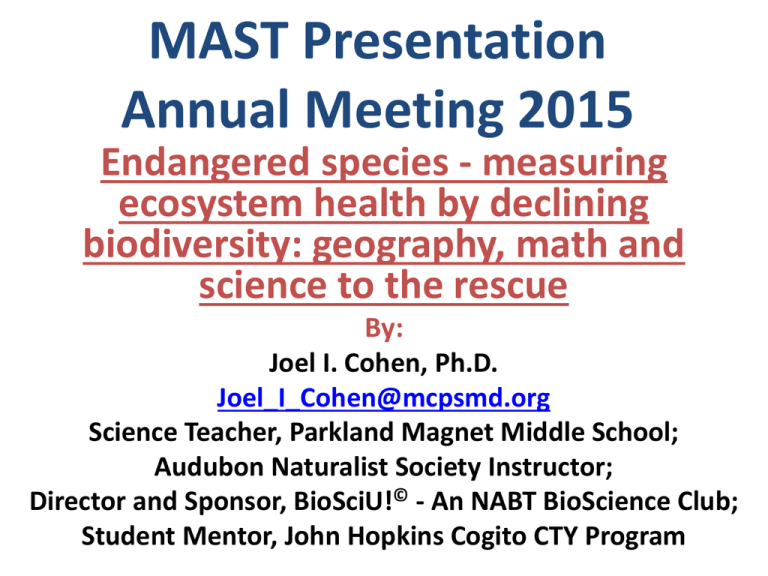
MAST Presentation Annual Meeting 2015 Endangered species - measuring ecosystem health by declining biodiversity: geography, math and science to the rescue By: Joel I. Cohen, Ph.D. Joel_I_Cohen@mcpsmd.org Science Teacher, Parkland Magnet Middle School; Audubon Naturalist Society Instructor; Director and Sponsor, BioSciU!© - An NABT BioScience Club; Student Mentor, John Hopkins Cogito CTY Program E.O. Wilson “Education in biology is important not just for the welfare of humanity but for the survival of the rest of life. Every conservationist with whom I have discussed the subject agreed that the general indifference of people to the living world is the failure of introductory education in biology. As I have urged, half of biology now and probably more then half in the future lies in the study of biodiversity and the living environment.” From The Creation The Problem? • Can students use and access data regarding human-caused extinctions or declines in population? • Can use of such data contribute to understanding current rates of biodiversity impoverishment? • Can endangered species data be used to address the questions above? Learning Outcomes In conjunction with NGSS, the lesson described supports student learning by asking them to: 1. compose a letter to family explaining what biodiversity is & how humans affect species 2. complete a 15 species organizer for living animal and conservation presentation, noting conservation concerns such as habitat loss and urbanization 3. analyze and compare data for six endangered or extinct animals and develop report or poster 4. complete a before/after survey on biodiversity, ethical perspectives, and impact of current lesson 5. answer assessment questions on biodiversity and the Anthropocene extinction as part of test on evolution. The Current state of affairs, or, the sixth extinction, or the Anthropocene or quaternary extinction The Current state of affairs, or, the sixth extinction, or the Anthropocene or quaternary extinction Using the IUCN Red Book Categories of Endangerment Endangered and rare animals in my classroom at Parkland 2015 List of Species for Observation Common Name Genus species Habitat Conservation Status 1. Reticulated python Python reticulatus Southeast Asia; rain forests, woodlands, and nearby grasslands. It is also associated with rivers and is found in areas with nearby streams and lakes Unprotected; world's longest snakes and longest reptile 2. Green Anaconda Eunectes murinus A member of the boa family, South America’s green anaconda is, pound for pound, the largest snake in the world. Anacondas live in swamps, marshes, and slow-moving streams, mainly in the tropical rain forests of the Amazon. Not listed 3. Woma python Aspidites ramsayi Arid, coastal, dune; terrestrial habitat Endangered species; protected 4. Rosy boa Lichanura Trivirgata This species occurs in southwestern United States and northwestern Mexico. Unprotected 5. California king snake Lampropeltis getula califoorniae From OR in the north to the Baja peninsula in the south. West to southern UT and all but the most eastern parts of AZ. Can be found in most all habitat types except the highest elevations. Unprotected; local collecting limits are in place for certain parts of its range 6. Taiwan beauty snake Orthriophis taeniurus archipelago islands; Asia, Russia Not yet evaluated 7. Bearded Dragon Pogon abarbata Found throughout most of central Australia. Arid Not protected; however export from Australia is illegal Observations and Notes Anthropocene Species Event Index (ASEI) – An Indicator of Species Diversity Mathematical index relating: D: year of species discovery in modern terms C: year when decline in species is noted due to human interventions, and a plea is made for conservation Year when: E: species becomes extinct R: species enters recovery Figure 1. Relation between four values (in years) describing the fate of an endangered species as used with the Anthropocene Species Event Index (ASEI). Point C: Year when population decline was first noted, referred to as the point of Concern (C) D C Point D: Year when first popular or scientific description of species occurred Point E: year when species went extinct in the wild E OR R Point R: year in which a species population entered some form of recovery, either wild or captivity. Figure 2. Fourteen species listed by IUCN category and ASEI values for years taken to reach either species extinction or recovery. EXT Toad, Golden CE Porpoise, vaquita EXT Grebe, Atitlán E Gorilla, Eastern Mountain EXT Wallaby, toolache E Python, Woma E Ferret, Black Footed LC Pelican, Brown EXT Tasmanian tiger E Tamarin, Golden Lion CE Grouper, Atlantic goliath CE Condor, Californian V Species Name Tortoise, African spurred V IUCN Status Tortoise, Galápagos giant ASEI Data Intervals Year of Description minus year concern voiced over population decline Year of Recovery or Extinction minus the year of concern 0 50 100 150 Intervals shown in Years 200 250 300 350 400 Geography: Identifying country, region and ecology where endangered/extinct species are/were found Species: _____________________ IUCN Category: __________________ Habitat: ________________________ Reason endangered: ______________ _______________________________ Species decline noted: _______ Washington DC; 20240 1849 C Street, N.W. Department of the Interior Secretary Sally Jewel, Mail to: Saving Biodiversity, One Species at a Time Years in recovery: _____________ Parkland Magnet Middle School 6401 West Frankfort Drive Science 7A – Human Space Exploration; c/o Dr. Cohen Rockville, MD 20852 Picture By: ___________________________ Hi Dr. Cohen, I called yesterday to speak to you, but was recommended to try email instead. I am the person who received all the of the species biodiversity postcards your students sent! I would love to respond either with a letter or email (whatever you prefer) to let the students know that I received them, but there was no other indication of why they sent them to the Department of Interior. I'm not sure if there was a letter accompanying them originally, but any type of information about what they are trying to accomplish or learn about would be great. For example, are they demonstrating their concern for animals around the world? Do they want the government to protect these animals? Are they looking for more information on these animals? So, when you get a chance, can you let me know what the overall purpose of the exercise was, and I'll be sure to use that in my response. Thank you for encouraging your students to engage with the government and voice their concerns! Please feel free to call me if you'd like to talk further about this. Thanks, Valerie Fellows Communication Specialist U.S. Fish and Wildlife Service Ecological Services Program MS: ES 5275 Leesburg Pike Falls Church, VA 22041-3803 Phone: (703) 358-2285 References Cohen, J.I. 2015. Ethical Values and Biological Diversity: A Preliminary Assessment Approach. Journal of Microbiology and Biology Education 12/2014; 512.821:224-226. https://www.researchgate.net/publication/269634614_Ethical_Valu es_and_Biological_Diversity_A_Preliminary_Assessment_Approach Navaro-Perez, M. and K.G. Tidball. (2012). Challenges of biodiversity education: a review of educational strategies for biodiversity education. International Electronic Journal of Environmental Education: 2, 1: 13-30. Potter, C.S., Cohen, J.I. and Janezewski, D (Eds). (1993). Perspectives on Biodiversity: Case Studies of Genetic Resource Conservation and Development. AAAS Press, Washington DC. Cohen, J.I. In press, ABT. Biodiversity Education and the Anthropocene: An Indicator of Extinction or Recovery. 2016.



